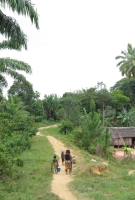Fanja Saholiarisoa
ANTANANARIVO, Jul 9 2009 (IPS) – Eight Malagasy women die per day while giving birth, either due to complications during the pregancny or during delivery, according to a recently-published national Demographic and Health Survey (DHS).

Sixty-five percent of Madagascar s rural population lives more than ten kilometres from the nearest health facility. Credit: Natalia Reiter/IRIN
As a result, Madagascar is unlikely to achieve Millennium Development Goal (MDG) 5, which aims to reduce maternal mortality by three quarters by 2015.
Madagascar s maternal mortality rate remains high at 469 per 100,000 live births, according to the survey. The key reason for this is postpartum haemorrhage (PPH), health experts say, which is defined as blood loss greater than 500 millilitres during vaginal delivery or greater than 1,000 mL during caesarean delivery.
PPH is a particular problem in resource-poor settings, like rural Madagascar, where access to health facilities and services is compromised.
In an attempt to improve maternal health, the Malagasy health department has now started to make the drug misoprostol, a drug developed to prevent gastric ulcers, but also used as an effective and relatively-cheap medicine to induce labour, available in 31 of the country s clinics.
This project will save the lives of many women in Madagascar and is an alternative for deliveries outside health centers, explains Thierry Ramanantsoa, a doctor at the Marie Stopes private hospital in Antananarivo, which initiated the project in collaboration with the health department.
Related IPS Articles
Ultimately, health authorities plan to provide the drug in all of the country s 111 districts. If the health department managed to (provide misoprostol) in all districts, the country can reduce its maternal death rate by 12 percent, estimated Jean Pierre Rakotovao, country representative of Venture Strategies for Health and Development (VSHD), a United States-registered NGO which financially supports the project.
Obstetric fistula
The second most common cause of maternal mortality in Madagascar is obstetric fistula, a medical condition in which a hole develops between either the rectum and vagina or between the bladder and vagina after severe or failed childbirth when adequate medical care is not available.
The condition is particularly common in teenage mothers. 157 out of 1,000 births are given by young women between 15 and 19 years, according to a 2004 DHS survey.
Teza Soa, a 17-year-old mother from Toliara, in Madagascar s south, lost her baby during delivery and later developed obstetric fistula. Her own life was saved thanks to a free surgery provided by health workers of the United Nations Fund for Population (UNFPA) a few days after the delivery. It was a difficult experience for me. Fortunately, I could access these (health) services, recalled Soa.
Preventable diseases such as PPH and obstetric fistula, are rampant due to a severe shortage of skilled health workers on the island. Although 80 percent of pregnant women receive prenatal consultation, only about half of births are attended by skilled health personnel and only a third of babies are born in a hospital setting, DHS researchers say.
Access to health care also remains limited because 65 percent of the rural population lives more than ten kilometres from the nearest health facility, without transport available to get there.
Lack of (access to) skilled attendants penalises many mothers, says Dr Edwige Ravaomamana, head of UNFPA s reproductive health programme.
But even if pregnant women manage to visit their nearest health facility, there is no guarantee that they will be able to access the services they need. Many clinics on the island have no special delivery rooms, and often there are more patients than beds. In some instances, women had to lie on wooden tables when giving birth.
Lack of resources
The local clinic in Belanitra, a rural community in Madagascar s north, is one such resource-poor health facility. It s hard to carry out interventions here in case of complications and because of the lack of hospital beds, complained Dr Augustine Rajoronary, the main physician of the clinic.
The clinic has only four beds, while about 20 women give birth here per month. Sometimes, we ask our patients to bring their own mattress, or the woman has to leave a few hours after labour to give room to others, he told IPS.
Hopes are high that the introduction of misoprostol and improved fistula care will make a difference to maternal mortality rates. Previous efforts by the national health department to improve maternal health have had some success, but did not sufficiently decrease the numbers of death.
A couple of years ago, for example, the Ministry of Health, Family Planning and Social Welfare started to integrate traditional birth attendants into the health system because to assist child birth in remote, rural areas. About 500 midwives were trained, and they facilitate about 60 percent of deliveries.
Yet, midwives do not have the skills or resources to handle complications at child birth. Apart from the low use of services in antenatal clinics, there is the low rate of births attended by skilled personnel. Only 21 percent of births are medically monitored, and 66.4 percent take place at home, explained UNFPA representative Benoït Kalassa.
UNFPA provided $1.3 million to strengthen maternal health services in the country in 2008 and 2009. Apart from treating fistula, UNFPA provides free family planning services and caesarean sections in public health care centres.